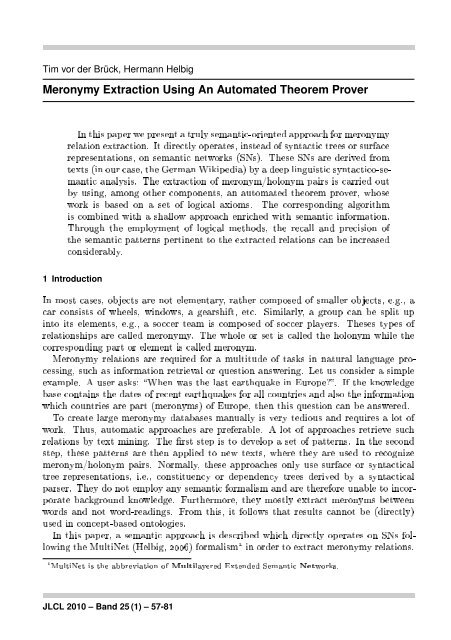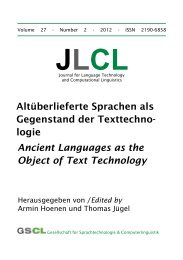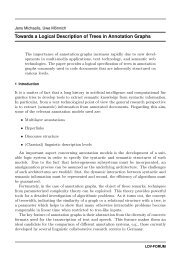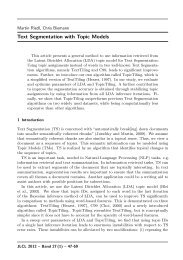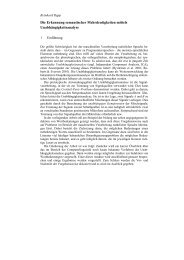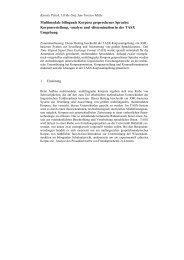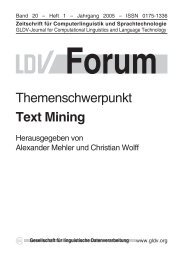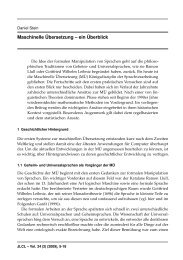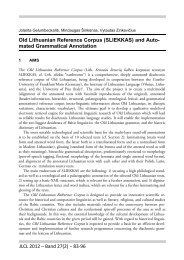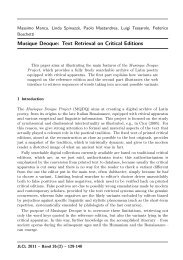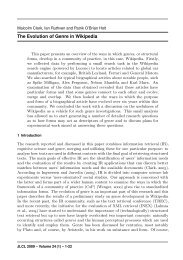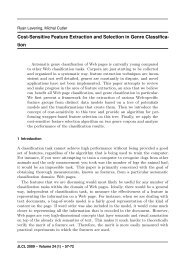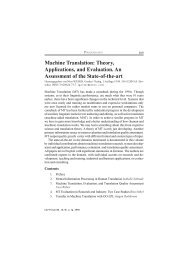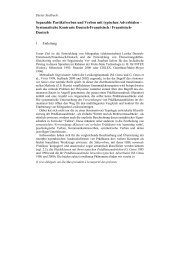Meronymy Extraction Using An Automated Theorem Prover - JLCL
Meronymy Extraction Using An Automated Theorem Prover - JLCL
Meronymy Extraction Using An Automated Theorem Prover - JLCL
You also want an ePaper? Increase the reach of your titles
YUMPU automatically turns print PDFs into web optimized ePapers that Google loves.
Tim vor der Brück, Hermann Helbig<br />
<strong>Meronymy</strong> <strong>Extraction</strong> <strong>Using</strong> <strong>An</strong> <strong>Automated</strong> <strong>Theorem</strong> <strong>Prover</strong><br />
In this paper we present a truly semantic-oriented approach for meronymy<br />
relation extraction. It directly operates, instead of syntactic trees or surface<br />
representations, on semantic networks (SNs). These SNs are derived from<br />
texts (in our case, the German Wikipedia) by a deep linguistic syntactico-se<br />
mantic analysis. The extraction of meronym/holonym pairs is carried out<br />
by using, among other components, an automated theorem prover, whose<br />
work is based on a set of logical axioms. The corresponding algorithm<br />
is combined with a shallow approach enriched with semantic information.<br />
Through the employment of logical methods, the recall and precision of<br />
the semantic patterns pertinent to the extracted relations can be increased<br />
considerably.<br />
1 Introduction<br />
In most cases, objects are not elementary, rather composed of smaller objects, e.g., a<br />
car consists of wheels, windows, a gearshift, etc. Similarly, a group can be split up<br />
into its elements, e.g., a soccer team is composed of soccer players. Theses types of<br />
relationships are called meronymy. The whole or set is called the holonym while the<br />
corresponding part or element is called meronym.<br />
<strong>Meronymy</strong> relations are required for a multitude of tasks in natural language pro<br />
cessing, such as information retrieval or question answering. Let us consider a simple<br />
example. A user asks: When was the last earthquake in Europe?. If the knowledge<br />
base contains the dates of recent earthquakes for all countries and also the information<br />
which countries are part (meronyms) of Europe, then this question can be answered.<br />
To create large meronymy databases manually is very tedious and requires a lot of<br />
work. Thus, automatic approaches are preferable. A lot of approaches retrieve such<br />
relations by text mining. The rst step is to develop a set of patterns. In the second<br />
step, these patterns are then applied to new texts, where they are used to recognize<br />
meronym/holonym pairs. Normally, these approaches only use surface or syntactical<br />
tree representations, i.e., constituency or dependency trees derived by a syntactical<br />
parser. They do not employ any semantic formalism and are therefore unable to incor<br />
porate background knowledge. Furthermore, they mostly extract meronyms between<br />
words and not word-readings. From this, it follows that results cannot be (directly)<br />
used in concept-based ontologies.<br />
In this paper, a semantic approach is described which directly operates on SNs fol<br />
lowing the MultiNet (Helbig, 2006) formalism 1 in order to extract meronymy relations.<br />
1 MultiNet is the abbreviation of Multilayered Extended Semantic Networks.<br />
<strong>JLCL</strong> 2010 – Band 25 (1) – 57-81
vor der Brück, Helbig<br />
This approach takes a knowledge base and a set of logical axioms into account. To this<br />
end, the entire content of the German Wikipedia with more than 20 million sentences<br />
is transformed into SNs using the WOCADI parser (Hartrumpf, 2002). The extraction<br />
patterns dened on a semantic level are mainly derived from the patterns given in<br />
(Girju et al., 2006). It is combined with a method based on shallow patterns enriched<br />
with semantic information if present.<br />
In the next section, we review existing work on meronymy extraction. Section 3<br />
describes the MultiNet formalism which is our representation for texts. <strong>An</strong> overview<br />
about the application of semantic patterns based on the MultiNet formalism is pre<br />
sented in Section 4. Section 5 describes how to incorporate a set of logical axioms and<br />
a knowledge base. The validation of extracted meronymy hypotheses is presented in<br />
Section 6. Section 7 illustrates how the correct meronymy subrelation can be selected.<br />
The architecture of our meronymy extraction system is given in Section 8. Evaluation<br />
results are specied in Section 9. Finally, the conclusion and an outlook of future work<br />
is given in Section 10.<br />
2 Review of Existing Work<br />
In this section, we give an overview on existing work on meronymy extraction. Quite<br />
popular are pattern-based approaches. Table 1 lists a collection of the patterns dened<br />
by Girju et al. (2006).<br />
ID Surface Pattern Example<br />
S 1 NP mero is part of NP holo the engine is part of the car<br />
S 2 NP holo 's NP mero girl's mouth<br />
S 3 NP mero of NP holo eyes of the baby<br />
S 4 NP holo verb:have NP mero The table has four legs.<br />
S 5 NP holo P NP mero A bird without wings cannot y.<br />
S 6 NP mero P NP holo A room in the house.<br />
S 7 NP(N holo N mero) (noun compound) door knob<br />
S 8 NP(N mero N holo ) (noun compound) turkey pie<br />
Table 1: Some of the patterns suggested for the recognition of meronyms by Girju et al. (the lower indices<br />
mean: mero=meronym, holo=holonym)<br />
These patterns are applied to arbitrary texts, and the instantiated variable NP mero<br />
is extracted as meronym hypothesis of the assumed holonym NP holo . Since hypotheses<br />
extracted by these patterns are not always correct, an additional validation component<br />
is required. Girju et al. employ a decision tree on annotated meronymy training data<br />
by making use of the WordNet hypernymy hierarchy.<br />
<strong>An</strong>other pattern based approach is introduced by (Berland and Charniak, 1999). The<br />
validation of the extracted hypotheses is done by several statistical features taking the<br />
pattern by which a meronymy hypothesis was extracted into account as well as how<br />
likely the occurrence of the holonym hypothesis is if the given meronym hypothesis<br />
58 <strong>JLCL</strong>
<strong>Theorem</strong> <strong>Prover</strong> Based <strong>Meronymy</strong> <strong>Extraction</strong><br />
shows up. In contrast to the approach of Girju et al., this method is not supervised<br />
and needs no annotated data.<br />
Some of the patterns are very often applicable but the extracted hypotheses are rarely<br />
correct. <strong>An</strong> example of such a pattern is NP holo 's NP mero, as proposed by Girju et al.<br />
(2006). The ESPRESSO system introduced a bootstrapping approach geared towards<br />
handling this problem in particular. The reliability scores of relation hypotheses are<br />
used to derive reliability scores for the patterns that extracted such hypotheses and<br />
vice-versa (Pantel and Pennacchiotti, 2006).<br />
<strong>An</strong> alternative approach to pattern matching is the use of support vector machines<br />
and tree kernel functions, which are employed to assign one of several semantic rela<br />
tions including meronymy to a given word or concept pair. A tree kernel function is<br />
a function for comparing trees, where the matrix of kernel values is symmetric and<br />
positive-semidenite. Such approaches follow the assumption that a certain semantic<br />
relation (e.g., meronymy) is quite likely to hold if there exist a lot of sentences with<br />
similar tree structures (or similar paths in the dependency trees) in which this relation<br />
is known to hold (Culotta and Sorenson, 2004; Bunescu and Mooney, 2005; Zhao and<br />
Grishman, 2005; Reichartz et al., 2009).<br />
Current approaches for meronymy extraction as described above are practically nei<br />
ther semantic-based nor do they take background knowledge into account. Let us con<br />
sider two examples which demonstrate how background knowledge can improve the<br />
evaluation results.<br />
The following pattern is given:<br />
mero(a1 , a2 ) ← a1 is a member of a2<br />
This formula species that if a sentence contains the statement that a1 is a member<br />
of a2, then a1 is also a meronym (element) of a2. This pattern can be applied to<br />
the sentence Mr. Peters is a member of AT&A. to derive the meronymy relation 2<br />
mero(Mr.P eters, AT &T ). Now consider the sentence: Mr. Peters is the leader of<br />
AT&T. Naturally, the pattern is not applicable to this sentence. However, if we use<br />
background knowledge, then the fact that Mr. Peters is a member of AT&T can<br />
eventually be inferred by the fact that Mr. Peters is the leader of AT&T, which makes<br />
the pattern applicable. Thus, a large knowledge base can reduce the number of required<br />
patterns considerably and therefore the amount of work for the pattern developer. In<br />
this example the knowledge base was employed to improve the recall but it is also<br />
possible to improve precision.<br />
Consider a sentence matching the surface pattern x is a mixture of y and z<br />
(e.g., Water is a mixture of hydrogen and oxygen.). Two meronymy relations can<br />
be extracted from such a sentence: mero(y, x) and mero(z, x) (in the example<br />
mero(hydrogen, water) and mero(oxygen, water)). Note that the word mixture can<br />
also be used in a more abstract sense, e.g., His attitude is a mixture of enthusiasm and<br />
diligence. In order to prevent in this case the extraction of assumed meronymy rela<br />
2 This expression is not a valid MultiNet expression but stated rather informally.<br />
Band 25 (1) – 2010 59
vor der Brück, Helbig<br />
tions like mero(enthusiasm, attitude) and mero(diligence, attitude), one has to require<br />
that x and/or y/z are known to be hyponyms of substance, which can be expressed<br />
by a logical constraint taking the transitivity axiom of hyponymy into account. This<br />
example is described in more detail in Section 5.<br />
Finally, a knowledge base can be advantageous for a multitude of other tasks, e.g.,<br />
the majority of the axioms presented here are also used for question answering.<br />
3 MultiNet as a Fine-grained Semantic Network Formalism<br />
As described in Section 2, axioms can be used to make patterns more generally usable<br />
or to support the specications of logical constraints. Naturally, in order to use logical<br />
axioms, all sentences have to be converted into a logical representation. We have de<br />
cided to use the MultiNet SN formalism since this is a logical representation with great<br />
expressiveness (even beyond rst order predicate logic) and is excellently supported by<br />
several software tools. In contrast to networks such as GermaNet (Hamp and Feldweg,<br />
1997) or WordNet (Fellbaum, 1998), MultiNet is designed to represent both semantic<br />
and lexical relations between lexems as well as the meaning of whole natural language<br />
expressions. <strong>An</strong> SN consists of nodes representing concepts (word readings) and arcs<br />
denoting relations between concepts or functions involving concepts. In total there are<br />
approximately 120 relations and functions dened in MultiNet, including the following:<br />
ˆ arg1/2: Specication of relational arguments at the metalevel<br />
ˆ attch: Attachment of an objects to another object<br />
ˆ attr/val: Attribute-value specication<br />
ˆ elmt: Element relation<br />
ˆ hsit: Relation specifying the constituents of a hyper-situation<br />
ˆ *itms: Function enumerating a set<br />
ˆ mero: <strong>Meronymy</strong> relation, hyper-relation of elmt, hsit, origm −1 , pars, subm,<br />
and temp<br />
ˆ origm: Relation of material origin<br />
ˆ pars: <strong>Meronymy</strong> relation except elmt, hsit, origm −1 , subm, and temp<br />
ˆ *pmod: Modication of objects by associative or operational properties<br />
ˆ pred: Predicative concept characterizing a plurality<br />
ˆ sub: Relation of subordination for conceptual objects (hyponym/instance of)<br />
ˆ sub0: Relation of general hyponymy, hyper-relation of sub, subr and subs<br />
ˆ subm: Set inclusion (subset)<br />
ˆ subr: Relation of conceptual subordination for relations<br />
ˆ subs: Relation of conceptual subordination for situations<br />
ˆ temp: Relation specifying the temporal embedding of a relation<br />
In MultiNet, concepts are specied by a word label and a pair of indices .n.m in<br />
dicating the intended reading from a list of homographs or sememes of a polysemic<br />
word, respectively. These indices will henceforth be omitted from the text for the sake<br />
of brevity.<br />
60 <strong>JLCL</strong>
<strong>Theorem</strong> <strong>Prover</strong> Based <strong>Meronymy</strong> <strong>Extraction</strong><br />
MultiNet is connected to the semantic lexicon HaGenLex (Hartrumpf et al., 2003).<br />
Each lexical entry of HaGenLex contains, aside from the typical morpho-syntactical<br />
information, one or more ontological sorts, a set of semantic features, and several layer<br />
features. The ontological sorts (currently more than 40) form a taxonomy. In contrast<br />
to other taxonomies, ontological sorts are not necessarily lexicalized, i.e., their names<br />
do not necessarily denote lexical entries.<br />
The following list shows a small selection of ontological sorts:<br />
ˆ Object (o)<br />
Concrete object (co): e.g., milk, chair<br />
* Discrete object (d): e.g., chair<br />
* Substance (s): e.g., milk, honey<br />
Abstract object (ab): e.g., thought, idea<br />
* Abstract temporal object (ta): e.g., month<br />
ˆ Situation (si): e.g., being warm<br />
ˆ Quality (ql)<br />
Property in the narrower sense (p): e.g., tall, heavy<br />
Functional quality (fq): Such a quality obtains their full meaning only in<br />
connection with another entity.<br />
* Associative quality (aq), e.g., chemical, philosophical<br />
* Operational property (oq), e.g., latter, third<br />
Semantic features denote semantic properties of objects; the values can be '+' (meaning<br />
applicable), '-' (not applicable) or 'underspecied'. A selection of semantic features is<br />
provided below:<br />
ˆ animal<br />
ˆ animate<br />
ˆ artif (articial)<br />
ˆ human<br />
ˆ spatial<br />
ˆ thconc (theoretical concept).<br />
Sample characteristics of the nominal concept bear:<br />
ˆ Ontological sort: d (discrete object)<br />
ˆ Semantic features: animal +, animate +, artif -, human -, spatial +, thconc<br />
-, . . .<br />
In this paper we only employ the layer feature type of extensionality (etype). There<br />
fore only this feature is described. It classies nodes on the pre-extensional knowledge<br />
representation level (see (Helbig, 2006) or (Lyons, 2002) for a distinction of intensional<br />
and (pre)extensional interpretation) and can assume one of the following values:<br />
0: Representative of the extensional of an elementary concept, which is itself not a<br />
set, e.g., house, Max (person named Max)<br />
1: Set of elements of type 0, e.g., several children, three cars, team, brigade<br />
2: Set of elements of type 1, e.g., three crews, many organizations, umbrella organi<br />
zation<br />
3: Set of elements of type 2, e.g., three umbrella organizations<br />
Band 25 (1) – 2010 61
vor der Brück, Helbig<br />
This list can theoretically be continued to arbitrary type numbers but only types of<br />
extensionality until the value of three are realistic in practice.<br />
The networks expressed in the MultiNet formalism are obtained from surface texts<br />
by means of the syntactico-semantic parser WOCADI (Hartrumpf, 2002), based on a<br />
word-class controlled functional analysis. Note that, although a meronymy relation can<br />
be represented in the MultiNet formalism, it is usually not contained in the SNs which<br />
are created by the parser unless such a relation is already comprised in the knowledge<br />
base.<br />
city<br />
SUB<br />
[name: cologne]<br />
SUB<br />
c2<br />
<br />
SUB<br />
ATTCH<br />
MERO<br />
SUB<br />
ARG2<br />
ARG1<br />
[name: lindenthal]<br />
c1<br />
SUBR<br />
district<br />
TEMP<br />
SUBR<br />
part<br />
present<br />
sub<br />
Figure 1: Application of the deep pattern D 4 to an SN representing the sentence: Lindenthal is a district<br />
of Cologne. Inferred edges are marked by dashed lines. SUBR(c1, sub) indicates that the two<br />
arguments of c1 (c2 and c3) are connected by a SUB relation.<br />
<strong>An</strong> example of an SN based on the MultiNet formalism is given 3 in Figure 1 and<br />
represents the sentence: Lindenthal is a district of Cologne. The specication of names<br />
(here Lindenthal and Cologne) is done by attribute/value constructs (MultiNet rela<br />
tions: attr and val). For better readability, an attribute value construct connected<br />
with a node c and subordinated to an attribute named n with value v, which is rep<br />
resented by the MultiNet expression attr(c, d) ∧ sub(d, n) ∧ val(d, v), is written as<br />
[n ∶ v] in this gure. The parser recognized that a hyponymy relation is specied<br />
(subr(c1,sub)) and that the concept named Lindenthal is a hyponym (MultiNet rela<br />
tion: sub) of the concept capsule associated to district of Cologne. The preposition of<br />
is realized by the relation attch (attach) in the SN.<br />
3 Concept names are translated from German into English for better readability.<br />
62 <strong>JLCL</strong>
<strong>Theorem</strong> <strong>Prover</strong> Based <strong>Meronymy</strong> <strong>Extraction</strong><br />
ID Deep Pattern Example<br />
D 1<br />
mero(a1 , a2 ) ← subs(d, consist) ∧ arg1(d, e)∧<br />
sub(e, a2 ) ∧ arg2(d, f)∧<br />
P AR *itms (f, g) ∧ pred(g, a1 )<br />
D 2<br />
mero(a1 , a2 ) ← sub(c, a1 )∧<br />
attch(d, c) ∧ sub(d, a2 )<br />
mero(a1 , a2 ) ← arg1(e, d) ∧ sub(d, a2 )∧<br />
arg2(e, f) ∧ sub(f, mixture)∧<br />
D 3 attch(g, f) ∧ P AR *itms (g, h) ∧ sub(h, a1 )∧<br />
subr(e, sub) ∧ (sub(a2 , substance)∨<br />
sub(a1 , substance)) ∧ a2 ≠ mixture<br />
N 1 ∶= attr(a1 , e) ∧ sub(e, name) ∧ val(e, d)<br />
N 2 ∶= attr(a2 , g) ∧ sub(g, name) ∧ val(g, h)<br />
mero(a1 , a2 ) ∧ N 1 ∧ N 2 ←<br />
D 4 N 1 ∧ N 2 ∧<br />
arg1(c, a1 ) ∧ arg2(c, f)∧<br />
sub(f, part) ∧ attch(a2 , f)∧<br />
subr(c, sub)<br />
mero(a1 , a2 ) ← arg1(d, e)∧<br />
P AR *itms (e, f) ∧ sub(f, a1 )∧<br />
D 5 arg2(d, g) ∧ pred(g, part)∧<br />
attch(h, g) ∧ sub(g, a2 )∧<br />
subr(d, equ)<br />
mero(a1 , a2 ) ← sub(d, member)∧<br />
D 6 attch(e, d) ∧ sub(e, a2 ) ∧ arg2(f, d)∧<br />
arg1(f, g) ∧ sub(g, d) ∧ sub(g, a1 )<br />
A car (a2) consists of<br />
wheels (a1),. . .<br />
wheel(a1) of a car(a2)<br />
Water (a2) is a mixture of<br />
hydrogen (a1) and . . ..<br />
Germany (a1) is part<br />
of Europe (a2).<br />
Wheels, windows and a<br />
roof (a1) are part of<br />
car (a2).<br />
A goalkeeper (a1) is<br />
a member of a<br />
soccer-team (a2).<br />
Table 2: A selection of deep meronymy patterns formulated by means of MultiNet relations<br />
(P AR f (x, y) denotes the fact that x is the result of function f where one of the arguments of f is<br />
y).<br />
4 Application of Deep <strong>Meronymy</strong> Patterns<br />
The meronymy extraction process is based on semantic patterns (see Table 2). Each<br />
pattern consists of a premise and a conclusion mero(a1 , a2 ) (mero is the MultiNet<br />
relation indicating meronymy) for generic concepts and mero(a1 , a2 ) ∧ N 1 ∧ N 2 for<br />
instances where N 1 and N 2 are attribute/value constructs for a1 and a2 . The premise<br />
is given as an SN. Two of the nodes in this SN should be labeled with a1 and a2 in<br />
order for the pattern be applicable.<br />
Band 25 (1) – 2010 63
vor der Brück, Helbig<br />
Shallow pattern<br />
mero(a1 , a2 ) ← a1 ((word of))<br />
? (((cat (art)))) a2<br />
mero(a1 , a2 ) ← a2 ((word with )) a1<br />
mero(a1 , a2 ) ← a2 ((word without)) a1<br />
mero(a1 , a2 ) ← a1 ((word is))<br />
((word the)) ((word main component)<br />
((word of)) a2<br />
mero(a1 , a2 ) ← a1 * (((word ,))<br />
? (((cat (art)))) a1)<br />
((word and)) a1 ((word are))<br />
((word parts)) ((word of))<br />
? (((cat (art)))) a2<br />
mero(a1 , a2 ) ← a1 * (((word ,))<br />
? (((cat (art)))) a1)<br />
((word and)) ? (((cat (art))))<br />
a ((word are))<br />
((word components))<br />
((word of)) ? (((cat (art)))) a2)<br />
mero(a1 , a2 ) ← a2 ((word consists))<br />
((word of)) a1 ? ( * (((word ,)) a1)<br />
((word and)) a1))<br />
Matching expression<br />
wheel (a1) of a car (a2)<br />
house (a2) with balcony (a1)<br />
bird (a2) without wings (a1)<br />
A CPU (a1) is the<br />
main component<br />
of computers (a2).<br />
CPU (a1), . . .are parts of<br />
a computer (a2)<br />
CPU (a1) and<br />
display card (a1) are<br />
components of<br />
computers (a2)<br />
a computer (a2) consists<br />
of transistors (a1),. . .<br />
Table 3: Selection of shallow patterns for meronymy extraction. The expressions occurring in the patterns are<br />
translated from German to English.<br />
The matching of the pattern with an SN is done by an automated theorem prover<br />
for rst order predicate calculus. In comparison to ordinary pattern matching, this has<br />
the advantage that logical axioms can be included into the pattern-matching process.<br />
Note that this paper only describes the use of a theorem prover for extracting and not<br />
for validating meronymy hypotheses, which is, for instance done by Suchanek et al.<br />
(2009); vor der Brück and Stenzhorn (2010). In total, there are 19 deep patterns which<br />
are mainly derived from the patterns introduced by (Girju et al., 2006).<br />
To apply a pattern of the form 4 mero(a1 , a2 ) ← premise, where both a1 and a2<br />
must show up in the premise, one has to nd the bindings I for a1 and a2 , which are<br />
4 Patterns for instances can be applied similarly.<br />
64 <strong>JLCL</strong>
<strong>Theorem</strong> <strong>Prover</strong> Based <strong>Meronymy</strong> <strong>Extraction</strong><br />
required to cause the following formula to become a tautology:<br />
mero(a1 I , a2 I ) ←<br />
((mero(a1 I , a2 I ) ← premise I ) ∧ SNX)<br />
(1)<br />
in which SNX = SN ∧ KB (KB=knowledge base). The knowledge base contains a<br />
set of axioms as well as a large number of lexical and semantic relations. If variable<br />
bindings are determined successfully, than the relation mero(a1 I , a2 I ) is extracted as<br />
meronymy hypothesis.<br />
The proof is found by deriving a contradiction (i.e., the empty clause) from the<br />
negated expression (1), using resolution:<br />
⊥ ≡(((mero(a1 I , a2 I ) ← premise I ) ∧ SNX)∧<br />
¬mero(a1 I , a2 I ) ⇔<br />
(Use distributive law and A ← B ≡ ¬B ∨ A)<br />
⊥ ≡¬premise I ∧ SNX ∧ ¬mero(a1 I , a2 I ) ⇐<br />
⊥ ≡¬premise I ∧ SNX<br />
(2)<br />
Thus, since the trivial case that mero(a1 I , a2 I ) already appears in the knowledge<br />
base, premise or SN should be disregarded, it is required to derive a contradiction from<br />
¬premise I ∧ SNX. This is done by showing that the empty clause can be obtained<br />
applying logical resolution on ¬premise I ∧ SNX. For this purpose, the MultiNet the<br />
orem prover is employed, which is also successfully used in question-answering tasks<br />
(Glöckner, 2007) and is optimized for this SN scenario. In our tests, the MultiNet the<br />
orem prover was ten times faster than the well-known general purpose theorem prover<br />
E-KRHyper (Baumgartner et al., 2007).<br />
For easier processing, functions with a variable number of arguments are converted<br />
into a set of binary relations. For each such function x p = f(x 1, . . . , x l ) we cre<br />
ate l relations P AR f (x p, x 1),. . .,P AR f (x p, x l ) to represent the parent-child relation<br />
ships between the result and the arguments and (l(l − 1))/2 relations to represent<br />
the sequence of the arguments: F OLL f (x i, x j) ⇔ i < j. Thus, an example expression<br />
res = *itms(x 1, x 2, x 3) (the MultiNet relation *itms combines several concepts in a<br />
conjunction) can be replaced by the following formula:<br />
P AR(res, x 1) ∧ P AR(res, x 2) ∧ P AR(res, x 3)∧<br />
*itms<br />
*itms<br />
*itms<br />
F OLL<br />
*itms<br />
(x 1, x 2) ∧ F OLL(x 1, x 3) ∧ F OLL(x 2, x 3)<br />
*itms<br />
*itms<br />
(3)<br />
In addition to deep patterns, several shallow patterns are employed. Instead of a<br />
SN the premise consists of a regular expression involving feature value structures. The<br />
features are<br />
ˆ word: surface word form<br />
ˆ lemmas: possible lemmas<br />
Band 25 (1) – 2010 65
vor der Brück, Helbig<br />
ˆ categories: possible categories<br />
ˆ parse-lemma: lemma disambiguated by the Word Sense Disambiguation of the<br />
parser<br />
ˆ parse-reading: concept disambiguated by the Word Sense Disambiguation of the<br />
parser<br />
These feature value structures are tried to be unied with the token information list<br />
provided by the parser. The most important employed shallow patterns are given<br />
in table 3. The applicability of these patterns could be further improved by adding<br />
additional optional tokens (like articles or adjectives). However, this make the patterns<br />
more dicult to read and also increases the extraction time. This is a drawback to<br />
deep patterns where such optional parameters are not needed.<br />
5 Support via Logical Axioms<br />
The use of an automated theorem prover together with the axiomatic apparatus of<br />
the MultiNet formalism has the advantage that the number of deep patterns can be<br />
considerably reduced compared with the number of shallow patterns. The axioms<br />
were mostly already developed for the task of question-answering and are reused for<br />
meronymy extraction.<br />
ID Axiom<br />
# Hypotheses<br />
A 1<br />
sub(x, s) ← sub(x, p)∧<br />
*pmod(p, q, s) ∧ sort(q) = oq<br />
25 576<br />
A 2 sub(x, z) ← sub0(x, y) ∧ sub(y, z) 14 258<br />
A 3<br />
P AR *itms (a, d) ∧ pred(d, c) ←<br />
pred(a, c) ∧ ¬ P AR *itms (e, a)<br />
2 117<br />
A 4<br />
subs(x, z) ← subs(x, y)∧<br />
subs(y, z)<br />
564<br />
A 5<br />
attch(a, e) ← loc(e, l)∧<br />
{*in(l, a) ∨ *at(l, a)}∧<br />
194<br />
{subs(e, s) ∨ preds(e, s)}<br />
A 6<br />
pred(x, s) ← pred(x, p)∧<br />
*pmod(p, q, s) ∧ sort(q) = oq<br />
81<br />
A 7<br />
sub(a, s) ← {agt(e, a) ∨ exp(e, a)∨<br />
mexp(e, a)} ∧ ctxt(e, c) ∧ sub(c, s)<br />
57<br />
Table 4: Selected MultiNet axioms and the number of extracted hypotheses.<br />
Table 4 presents the most successful axioms together with the number of hypotheses<br />
extractions for which a certain axiom was required. A 1 from Table 4 is required most<br />
often, where the function *pmod is used to combine a conceptual object s with an<br />
operational property 5 (see Section 3), denoted by q in axiom A 1, which yields a more<br />
5 Operational properties having sort oq and associative properties are in contrast to properties in<br />
the narrower sense, which are treated by the MultiNet relation prop (Helbig, 2006)).<br />
66 <strong>JLCL</strong>
<strong>Theorem</strong> <strong>Prover</strong> Based <strong>Meronymy</strong> <strong>Extraction</strong><br />
special object p. This axiom is needed, for example, to deduce that the rst violinist<br />
is a violinist.<br />
<strong>An</strong>other example illustrating the usefulness of axioms is axiom A 2 (see Table 4). This<br />
axiom states the (generalized) transitivity of the hyponymy relation. Let us consider<br />
the SN representing the sentence Lindenthal is a district of Cologne. as displayed in Fig<br />
ure 1. Let us further assume the knowledge base contains the fact: subr(district, part).<br />
The concept represented by node c2 is a hyponym of district. It can thus be inferred<br />
that c2 is also a hyponym of part. Thus, the deep pattern D 4 (see Table 2) correspond<br />
ing roughly to the surface pattern a1 is a part of a2 , can also be applied to this SN.<br />
This means that the pattern D 4 becomes more generally usable by using axiom A 2.<br />
A further frequently used axiom is<br />
A 3 ∶ P AR(a, d) ∧ pred(d, c) ← pred(a, c) ∧ ¬ P AR(e, a) (4)<br />
*itms<br />
*itms<br />
This axiom is employed to add an *itms-relation to a pred-edge, i.e., this axiom<br />
creates a coordination existing of exactly one element. In this way, a meronym inside<br />
and outside a coordination can be recognized by the same pattern.<br />
Examples: Car wheels are part of a car. Car wheels, a blinker and a gearshift<br />
are part of a car. By applying axiom A 3 and pattern D 4, the meronymy relation<br />
mero(car_wheel, car) can be extracted from both example sentences. The literal<br />
¬ P AR *itms (e, a) prevents the generated relation pred(d, c) to be expanded by a further<br />
application of this axiom.<br />
Axiom A 4 denes the transitivity of the subs-relation, and axiom A 5 states that<br />
an object located 'within' or 'at' another object is attached to this concept. A 6 is a<br />
variant of A 1; it only applies if pluralities (indicated by the MultiNet relation pred) are<br />
considered. Finally A 7 is required if people act in certain roles (Example: If someone<br />
does something as a father, then he is a father).<br />
Band 25 (1) – 2010 67
vor der Brück, Helbig<br />
oxygen<br />
SUB<br />
MERO<br />
hydrogen MERO<br />
c6<br />
water<br />
SUB<br />
*ITMS<br />
c5<br />
PAR *ITMS<br />
c4<br />
PAR *ITMS<br />
ATTCH<br />
SUB<br />
c3<br />
SUB<br />
ARG1<br />
SUB<br />
c2<br />
ARG2<br />
c1<br />
mixture<br />
TEMP<br />
SUBR<br />
present<br />
sub<br />
Figure 2: Application of the deep pattern D 3 to an SN representing the sentence: Water is a mixture of<br />
hydrogen and oxygen. The inferred edges are marked by dashed lines.<br />
In the examples above, the use of axioms increases the recall. However, axioms can<br />
also help to increase the precision.<br />
Consider the sentence Water is a mixture of hydrogen and oxygen. where the asso<br />
ciated SN is given 6 in Figure 2. subr(c1, sub) indicates that the two arguments of<br />
c1 (target concepts of arg1 and arg2) are connected by a sub relation. The *itms<br />
function is used to combine the two components hydrogen and oxygen in a conjunction.<br />
The two meronymy relations mero(oxygen, water) and mero(hydrogen, water) can<br />
be extracted from this sentence by applying pattern D 3 from Table 2 (roughly corre<br />
sponding to the surface pattern given in Equation 5) to the associated SN.<br />
mero(x, z) ∧ mero(y, z) ← z is a mixture of x and y (5)<br />
Note that the word mixture can also be used in a more abstract sense, e.g.,<br />
His attitude is a mixture of enthusiasm and diligence. In order to prevent, in this<br />
6 Please note that c5 and c6 are generic nodes, and the arcs labeled with mero should begin at c5<br />
and c6, respectively. The latter is achieved in a post-processing step.<br />
68 <strong>JLCL</strong>
<strong>Theorem</strong> <strong>Prover</strong> Based <strong>Meronymy</strong> <strong>Extraction</strong><br />
case, the extraction of assumed meronymy relations, like mero(enthusiasm, attitude)<br />
and mero(diligence, attitude), one has to require that at least one of y/z and x is<br />
known to be a substance, which is expressed by the disjunction sub(a2 , substance) ∨<br />
sub(a1 , substance) in pattern D 3. A disjunction is used instead of the conjunction<br />
sub(a2 , substance) ∧ sub(a1 , substance) since the lexical resources are limited and the<br />
hypernymy relations in the knowledge base are by no means complete. The pattern D 3<br />
is applicable to the sentence Water is a mixture of hydrogen and oxygen. since water is<br />
a substance. The fact that water is a substance is derived by several applications of the<br />
axiom A 2 Transitivity of sub. The logical restriction a 2 ≠ mixture is required in order<br />
to prevent the extraction of mero(oxygen, mixture) and mero(hydrogen, mixture).<br />
This pattern is not applicable in the aforementioned example, where mixture is used<br />
in an abstract sense, because neither attitude, diligence nor enthusiasm are hyponyms<br />
of substance.<br />
6 Validation<br />
Not all of the extracted meronymy hypotheses extracted by deep or shallow patterns<br />
are correct. Thus, a validation component is required which checks each hypothesis for<br />
correctness by several semantic and statistical features.<br />
The knowledge validation carried out is done in two steps. In the rst step we<br />
compare the ontological sorts of relational arguments and semantic features to each<br />
other and lter out hypotheses of non-allowed combinations. In the second step the<br />
remaining hypotheses are assigned a condence score which estimates their probability<br />
of correctness. This two step mechanism was chosen for performance reasons. In this<br />
way the size of the database containing the meronymy hypotheses and the runtime of<br />
the condence score computation can be greatly reduced.<br />
Since the condence score represents a probability, hypotheses with a score of at<br />
least 0.5 are considered to be correct. All other hypotheses are considered incorrect.<br />
This score can be useful for two reasons:<br />
ˆ Hypotheses with a score beyond a certain score threshold could automatically be<br />
added to the knowledge base.<br />
ˆ If the hypotheses are to be validated manually, the annotator can rst check the<br />
hypotheses with the high scores. In this way, he can add much more meronyms<br />
to the knowledge base in a given time interval than if he chooses the hypotheses<br />
randomly.<br />
6.1 Filtering<br />
Only certain combinations of ontological sorts and semantic features are permitted.<br />
For instance, a concept denoting a human being (semantic feature: human +) can only<br />
be meronym to another concept that denotes a set (recognizable in MultiNet by the<br />
type of extensionality). The type of extensionality is zero for an individual concept<br />
(which is not a set) and i for a set of elements of type i−1 for i > 0 (see Section 3). The<br />
Band 25 (1) – 2010 69
vor der Brück, Helbig<br />
ontological sorts of the meronym and holonym hypothesis must usually be identical<br />
(exception: sort s (substance) for meronym and d (discrete) for holonym or vice-versa<br />
are allowed).<br />
The permitted combinations of ontological sorts are specied manually, while the<br />
regularities concerning features, which are a lot more complicated, are automatically<br />
learned by a tree augmented naïve Bayes algorithm (TAN) (Friedmann et al., 1997).<br />
The training is done separately for dierent combinations of the type of extensional<br />
ity. The training data consists of a set of annotated meronymy relation hypotheses<br />
(meronym/no meronym) and lists of semantic features where the features are sought<br />
and found in the lexicon. Only relational candidates for whom semantic features and<br />
ontological sorts can be shown to be compatible are stored in the knowledge base.<br />
6.2 Scoring<br />
All hypotheses in the knowledge base are assigned a condence score. This is done<br />
by means of a support vector machine (SVM) applied on several feature values 7 and<br />
annotations. The SVM (here LIBSVM, Chang and Lin (2001)) determines the class<br />
(meronymy or non-meronymy) and a probability estimate for each candidate pair and<br />
is trained on a set of annotated meronymy hypotheses. The annotation is either one<br />
(1) for meronymy or zero for non-meronymy. If the classication is 'meronymy', the<br />
score is dened by this probability estimate, otherwise as one minus this value. The<br />
employed features are explained below:<br />
Use of a Taxonomy: This feature exploits a collection of known meronyms, hy<br />
ponyms, synonyms, as well as a list of known non-meronym pairs. For that we used<br />
the lexical and semantic relations contained in HaGenLex. These relations are in part<br />
handcrafted, and in part derived from Wiktionary. Additionally, GermaNet relations,<br />
where the synsets are mapped to HaGenLex concept ids, are employed. This method<br />
works as follows: Consider a given pair of concepts (a1 , a2 ) being meronymically re<br />
lated to each other. Determine the Cartesian product S(a1 ) × S(a2 ) of all hypernyms<br />
of both normalized components (including the components itself). Increase a counter<br />
pos for all possible pairs of concepts in the resulting Cartesian product S(a1 ) × S(a2 ),<br />
i.e., set<br />
pos(x, y) ∶=pos(x, y) + 1<br />
∀x ∈ S(a1 ), y ∈ S(a2 )<br />
(6)<br />
where<br />
S(x) = {syno_normalize(x)} ∪ {syno_normalize(z)∣sub(x, z)} (7)<br />
7 not to be confused with semantic features<br />
70 <strong>JLCL</strong>
<strong>Theorem</strong> <strong>Prover</strong> Based <strong>Meronymy</strong> <strong>Extraction</strong><br />
where syno_normalize ∶ Concepts → Concepts is a function which maps a concept to<br />
the smallest element (according to some total ordering) of its synset:<br />
syno_normalize(c) = d ∶⇔ syno(d, c) ∧ (∀e ∶ syno(e, d) ⇒ e ≥ d) (8)<br />
Example: Assume synset(car)={auto,car}. Then syno_normalize(car) = auto if lex<br />
icographic ordering is used. By employing a synonymy normalization, the set of re<br />
garded concepts can be reduced which leads to a smaller memory consumption.<br />
<strong>An</strong>alogously to pos, determine neg(x, y) for all non-meronym pairs. For a new pair<br />
(x ′ , y ′ ) opt for meronymy, i<br />
max {<br />
a∈S(x ′ ),b∈S(y ′ )<br />
max {<br />
c∈S(x ′ ),d∈S(y ′ )<br />
pos(a,b)<br />
pos(a,b)+neg(a,b) } ><br />
(9)<br />
neg(c,d)<br />
} pos(c,d)+neg(c,d)<br />
That means that the decision is in favor of meronymy i there is a pair in S(x ′ )×S(y ′ )<br />
for which the indication for meronymy is stronger than the indication against meronymy<br />
for any other pair in S(x ′ ) × S(y ′ ). This decision procedure basically follows the<br />
approach presented by Costello (2007).<br />
In addition to the approach of Costello, we employed the taxonomy to cancel out<br />
all meronymy hypotheses that appear in or can be derived from this taxonomy since a<br />
meronym cannot be a hyponym or a hypernym simultaneously. If one or both of the<br />
considered concepts are associated to compound words, then we also check for known<br />
hyponymy relations between all combinations of meronymy concept+base concept and<br />
holonymy+base concept (base concept: concept corresponding to the correct reading<br />
of the base word) candidates.<br />
Correctness Rate: The feature Correctness Rate takes into account that the recog<br />
nized holonym alone is already a strong indication for the correctness or incorrectness<br />
of the investigated hypothesis. The same holds for the assumed meronym as well.<br />
For instance, meronymy candidate pairs with the assumed holonym computer, univer<br />
sity, or building were mostly correct. In contrast, meronymy candidate pairs with an<br />
assumed holonym future or reason were usually incorrect.<br />
Thus, this indicator determines how often a concept pair is actually correct if a<br />
certain concept shows up in the rst (meronym) or second (holonym) position. More<br />
formally, we are interested in determining the following probability:<br />
where<br />
p = P (me = t∣arg1 r = a1 ∧ arg2 r = a2 ) (10)<br />
ˆ arg1 r denotes the rst concept (the assumed meronym) in a given relation r.<br />
ˆ arg2 r denotes the second concept (the assumed holonym) in a given relation r.<br />
ˆ me(ronym) = t(rue) denotes the fact that a meronymy relation holds.<br />
Band 25 (1) – 2010 71
vor der Brück, Helbig<br />
Applying Bayes' theorem to Equation 10 leads to the Equation:<br />
p = P (me = t) ⋅<br />
P (arg1r = a1 ∧ arg2r = a2 ∣me = t)<br />
P (arg1 r = a1 ∧ arg2 r = a2 )<br />
For better generalization, we assume that the events arg1 r = a1 and arg2 r = a2 as<br />
well as (arg1 r = a1 ∣me = t) and (arg2 r = a2 ∣me = t) are independent. <strong>Using</strong> these<br />
assumptions, Equation 11 can be rewritten:<br />
(11)<br />
p ≈ p ′ = P (me = t) ⋅ P (arg1 r = a1 ∣me = t)<br />
⋅ P (arg2 r = a2 ∣me = t)<br />
P (arg1 r = a1 ) P (arg2 r = a2 )<br />
= P (arg1 r = a1 ∧ me = t) P (arg2<br />
⋅<br />
r = a2 ∧ me = t)<br />
P (arg1 r = a1 ) P (me = t) ⋅ P (arg2 r = a2 )<br />
p ′ 1<br />
=<br />
P (me = t) ⋅ P (me = t∣arg1 r = a1 ) ⋅ P (me = t∣arg2 r = a2 )<br />
If a1 only rarely occurs in meronym position in assumed meronymy relations, we<br />
approximate p by P (me = t∣arg2 r = a2 ), analogously for rarely occurring concepts in<br />
the holonym position. As usual, the probabilities are estimated by relative frequencies<br />
relying on a human annotation. Example: Let us consider that a hypothesis pair<br />
(c 1, c 2) is given and concept c 1 occurs in 90 annotated meronymy hypotheses as an<br />
assumed meronym, 45 of them are known to be correct. The concept c 2 occurs in 100<br />
hypotheses as holonym candidate and 30 of them are known to be correct. Let the<br />
probability that a meronym hypothesis is correct be 0.2. Then the total score is given<br />
as: (1/0.2) ⋅ 0.5 ⋅ 0.3 = 0.75.<br />
Graph Kernel: The use of kernels (see Section 2) is quite popular for semantic<br />
relation extraction. Since relation extraction algorithms are mainly based on syntactic<br />
or surface structures, tree or string kernels are usually applied. In our scenario, the<br />
kernel is only applied for validation of hypotheses where the extraction is done by<br />
the automated theorem prover. Hence, a hybrid approach is taken. In addition, our<br />
method is based on SNs, which are graphs and not trees. Thus, instead of the usual<br />
tree kernel, a graph kernel (vor der Brück and Helbig, 2010) based on common walks,<br />
as proposed by (Gärtner et al., 2003) is applied.<br />
Applied Pattern: There are major dierences regarding the precision values of the<br />
extracted meronymy hypotheses depending on the applied pattern (Berland and Char<br />
niak, 1999). Pattern D 1 (see Table 2) is actually quite reliable where D 2 generates a<br />
lot of incorrect hypotheses. Thus, we provide a feature for each pattern which takes the<br />
value of one if a meronymy hypothesis was extracted by this pattern, to zero otherwise.<br />
Mutual Information: Relation hypotheses extracted several times are often more re<br />
liable than hypotheses that could only be found once. Thus, we introduce a feature<br />
measuring the point-wise mutual information (in contrast to the conditional probabil<br />
ity in Berland and Charniak (1999)) between the meronym and holonym candidate<br />
multiplied by the discounting factor suggested in (Pantel and Ravichandran, 2004).<br />
(12)<br />
72 <strong>JLCL</strong>
<strong>Theorem</strong> <strong>Prover</strong> Based <strong>Meronymy</strong> <strong>Extraction</strong><br />
Deep/Shallow: This feature checks whether a hypothesis was extracted by both<br />
shallow and deep patterns (1) or only by one of them (0).<br />
Concrete/Abstract: This feature follows the assumption that most meronymically<br />
related concepts are concrete. It is the product of the concreteness of both meronym<br />
and holonym candidates. The concreteness of a single concept is dened as the fraction<br />
of ontological sorts for a concept that are concrete (ontological sort: co or subordinated<br />
to co). Note that a concept can be assigned several ontological sorts if it is a meaning<br />
molecule (Helbig, 2006). A meaning molecule is assigned several meaning facets where<br />
each facet can have dierent ontological sorts, features and types of extensionality. Let<br />
us consider an example for the calculation of the concreteness. If a concept is assigned<br />
two concrete sorts and one abstract, then the concreteness of this concept is 2/3.<br />
Ontological Sorts: Consider the case that at least one of the compared concepts<br />
involved in the meronymy hypothesis is a meaning molecule and is associated to several<br />
ontological sorts. The ltering process as described in Section 6.1 tests if there is at<br />
least one admissible combination of ontological sorts of the two concepts. All other<br />
ontological sorts are disregarded for this test. However, the disregarded ontological<br />
sorts can also give a clue about the hypothesis correctness. Therefore, we introduced a<br />
feature which employs the total set of ontological sorts of the two compared concepts.<br />
A meronymy relation is presumably more likely to hold if the involved concepts are<br />
assigned similar sets of ontological sorts. Thus, this feature is set to the Jaccard coe<br />
cient considering the ontological sorts of the meronym (m) and holonym (h) candidates:<br />
sort_feature(m, h) ∶=<br />
∣ sorts(m) ∩ sorts(h)∣<br />
∣ sorts(m) ∪ sorts(h)∣<br />
(13)<br />
7 <strong>Meronymy</strong> Subrelations<br />
The algorithm described thus far only extracts relations of type mero. However, the<br />
meronymy relation is divided into several subrelations. In this section we describe how<br />
the correct subrelation is chosen. First, we introduce the set of all subrelations to<br />
choose from. Second the decision procedure is described in detail.<br />
7.1 Types of <strong>Meronymy</strong> Relations<br />
Winston proposes six subrelations for meronymy (Winston et al., 1987), which unfor<br />
tunately are not suciently clearly dened. Therefore we base our approach on the<br />
meronymy relations of MultiNet (see (Helbig, 2006), Chapt. 4.2 and 18.2.49) which<br />
are systematically described and underpinned by an axiomatic apparatus. In the fol<br />
lowing it is tried to establish an approximate correspondence between both systems.<br />
Please note, that the division of meronymy of WordNet (Fellbaum, 1998) into three<br />
subrelations is considered by both aforementioned authors as being underspecied and<br />
not suciently dierentiated. The following subrelations are proposed by Winston:<br />
ˆ Component-integral: A relation between an object and one of its components.<br />
Important for this relation is the fact that object and component can be perceived<br />
Band 25 (1) – 2010 73
vor der Brück, Helbig<br />
separately from each other. MultiNet relation: pars (see Section 3). Example:<br />
A car wheel is part of a car.<br />
ˆ Member-collection: This relation represents the membership in a set. MultiNet<br />
relation: elmt. Example: A soccer player is a member of a soccer team.<br />
ˆ Portion-mass: Relations which refer to mass units and their parts. MultiNet rela<br />
tion: pars, for temporal units: temp. Example: A meter is part of a kilometer,<br />
a slice of the cake is part of the cake.<br />
ˆ Stu-object: This relation represents the chemical composition of an object.<br />
MultiNet relation: origm −1 if the holonym denotes a physical object, otherwise<br />
pars. Example: Alcohol is part of wine. Steel is part of a bike.<br />
ˆ Feature-activity: Activities can usually be divided into several subactions. Multi<br />
Net relation: hsit. Example: The following subactions belong to the activity<br />
going out for dinner: visiting a restaurant, ordering, eating and payment<br />
ˆ Place-area: This relation holds between two objects if one of these objects is<br />
geographically part of the other object. MultiNet relation: pars. Example:<br />
Germany is part of Europe.<br />
Additionally, (Helbig, 2006) denes a further meronymy subrelation for subsets called<br />
subm in MultiNet. Example: A brigade is a subset of a division. Note that<br />
brigade/division is not a member-collection relationship since both, a division and<br />
a brigade, denote concepts with sets as their extension, whose elements are soldiers.<br />
74 <strong>JLCL</strong>
<strong>Theorem</strong> <strong>Prover</strong> Based <strong>Meronymy</strong> <strong>Extraction</strong><br />
Premise<br />
etype(m) + 1 = etype(h)<br />
sort(m) ⊑ si∧<br />
sort(h) ⊑ si<br />
sort(m) ⊑ s∧<br />
sort(h) ⊑ d<br />
etype(m) = etype(h)∧<br />
etype(m) > 0<br />
sort(m) ⊑ ta∧<br />
sort(h) ⊑ ta<br />
otherwise<br />
Decision<br />
elmt<br />
hsit<br />
origm −1<br />
subm<br />
temp<br />
pars<br />
Table 5: Selecting the correct meronymy subrelation (d=discrete object, s=substance, si=situation,<br />
ta=temporal abstracta, m=meronym, h=holonym), sort(x) ⊑ y ∶⇔ sort(x) = y or sort(x) is<br />
a subsort of y.<br />
7.2 Selecting the Correct <strong>Meronymy</strong> Subrelation<br />
The semantic lexicon is employed to choose the correct subrelation for an extracted<br />
meronymy relation, i.e., this process is not based on any machine learning algorithm.<br />
The decision rules are given in Table 5. For the denition of ontological sorts and<br />
the type of extensionality, which are required for the decision process, see Section 3.<br />
This procedure requires that both concepts taken into consideration are contained<br />
in the lexicon. If this is not the case, then one of the following fall-back strategies<br />
are used. First, if one of the regarded concepts is represented by a compound word,<br />
as determined by a morphological compound analysis, then the lexical entry of the<br />
base concept (concept corresponding to the correct reading of the base word) can be<br />
used. Second, for correct meronymy relations, which is assumed for this selection, the<br />
semantic sorts of the two concepts must usually be identical (exception: origm −1 ).<br />
This means, for instance, that if the rst concept is known to be of sort ta the second<br />
should have the same sort and the correct subrelation should be temp. If a concept is<br />
a meaning molecule, the facets are chosen from both concepts for comparison, which<br />
are most similar in regard to ontological sorts and semantic features.<br />
Band 25 (1) – 2010 75
vor der Brück, Helbig<br />
HaGenLex<br />
Text<br />
Tokens<br />
Shallow Pattern<br />
Application<br />
Shallow patterns<br />
WOCADI<br />
<strong>An</strong>alysis<br />
Validation<br />
(Filter)<br />
SN<br />
KB<br />
Deep Pattern<br />
Application<br />
Deep patterns<br />
Subrelation<br />
Determination<br />
HKB<br />
Validation<br />
(Score)<br />
Figure 3: Activity diagram of the meronymy extraction done by SemQuire.<br />
8 Architecture<br />
To nd meronymy relations from a text, this text is processed by our knowledge acqui<br />
sition tool called SemQuire 8 (see Figure 3).<br />
1. At rst, the sentences of Wikipedia are analyzed by the deep linguistic parser<br />
WOCADI employing the knowledge base KB, containing the general background<br />
knowledge and the axiomatic apparatus.<br />
As a result of the parsing, a token list, a set of syntactic dependency trees, and<br />
a large semantic network (SN) are created.<br />
2. Shallow patterns, consisting of a regular expression in the premise, are applied to<br />
the token lists, and deep patterns are applied to the SNs to generate proposals<br />
for meronymy relations (see Section 4 and Section 5).<br />
3. A validation tool using ontological sorts and semantic features checks whether the<br />
proposals are at all technically admissible to reduce the amount of data stored in<br />
the hypotheses knowledge base HKB (see Section 6.1).<br />
4. If the validation is successful, the meronymy candidate pair is added to the HKB.<br />
Steps 24 are repeated until all sentences are processed.<br />
5. Each meronymy candidate pair in HKB is assigned a condence score (see Sec<br />
tion 6.2) estimating the likelihood of its correctness.<br />
6. The correct meronymy subrelation is determined (see Section 7).<br />
7. The highest scored hypotheses in HKB are manually inspected and eventually<br />
added to the knowledge base KB.<br />
8 SemQuire is derived from acquire knowledge semantic-based.<br />
76 <strong>JLCL</strong>
<strong>Theorem</strong> <strong>Prover</strong> Based <strong>Meronymy</strong> <strong>Extraction</strong><br />
Feature<br />
Correlation<br />
Deep/Shallow 0.512<br />
Ontological Sorts 0.436<br />
Correctness Rate 0.397<br />
Use of a Taxonomy 0.379<br />
Concrete/Abstract 0.337<br />
Mutual Information 0.030<br />
Table 6: Correlation of features to relation correctness<br />
9 Evaluation<br />
The meronymy relations automatically acquired stem from the German Wikipedia<br />
corpus from November 2006 consisting of 500 000 articles and 20 million sentences.<br />
In more than 6 million cases, a relation candidate was ltered out as being incorrect<br />
by our validation component. In total, 1 449 406 (dierent) meronymy relation hypothe<br />
ses were nally stored in the knowledge base, 286 008 of them originating exclusively<br />
from deep patterns. In total, the relations in the knowledge base were extracted by<br />
approximately 2.5 million pattern applications.<br />
GermaNet Costello SemQuire Sum<br />
PNM PM PNM PM PNM PM (PM+<br />
PNM)<br />
NM 750 0 506 244 666 84 750<br />
M 718 32 393 357 151 599 750<br />
Sum 1468 32 899 601 817 683<br />
Table 7: Confusion matrix for SVM optimization. NM = no meronymy relation present, M = meronymy relation<br />
present, PNM = predicted non-meronymy relation, PM = predicted meronymy relation.<br />
For relation hypotheses extracted by deep and shallow patterns together, the preci<br />
sion is more than three times higher than for the relations that were only extracted<br />
by shallow patterns. 1 450 of the relations of the knowledge base were extracted alone<br />
by employing the sub0 transitivity axiom A 2, exploiting the fact that a district de<br />
Measure GermaNet Costello SemQuire<br />
Accuracy 0.521 0.573 0.843<br />
Recall 0.043 0.476 0.799<br />
Precision 1.000 0.594 0.877<br />
F-measure 0.082 0.528 0.837<br />
Table 8: Accuracy, recall, precision, and F-measure for SVM optimization.<br />
Band 25 (1) – 2010 77
vor der Brück, Helbig<br />
notes a part (see the example in Section 5). In total, logical axioms have been applied<br />
in 58 101 relation extraction processes, discovering 34 114 distinct relations. Table 4<br />
shows a selection of axioms and the number of extracted hypotheses applying a certain<br />
axiom.<br />
1 500 hypotheses were selected for the evaluation and annotated for correctness. Ad<br />
ditional 50 000 hypotheses were annotated with their correctness exploited by the fea<br />
ture Correctness Rate, which is described in Section 6.2. Table 6 shows several scoring<br />
features and their associated correlation to the hypothesis correctness as specied by<br />
the annotators (one (1) for hypothesis is correct, zero (0) for incorrect).<br />
Accuracy, precision, recall, F-measure, and confusion matrices were determined by<br />
a 10-fold cross-validation. Precision is the relative frequency with which a predicted<br />
meronym is actually one, while accuracy denotes the relative frequency with which<br />
the decision (meronymy/non-meronymy) is in fact correct. Note that recall does not<br />
relate to the extraction process, but rather only to the (score-based) validation. Thus,<br />
it species the relative frequency with which a correct relation in the data set of 1500<br />
relations is actually identied as being correct by our system.<br />
Our approach is compared with a GermaNet classier as a baseline that predicts a<br />
relation of our hypotheses set to be meronymic if this relation is contained in GermaNet<br />
(GermaNet synsets are mapped to HaGenLex concepts semi-automatically) or can be<br />
derived by other GermaNet relations. A second baseline is the validation feature of<br />
Costello (Costello, 2007) which is also used as a feature by our system. The evaluation<br />
results are given in Tables 7 and 8. The evaluation showed that we were able to nd a lot<br />
of meronyms not contained in GermaNet. In particular, less than 6% of the meronyms<br />
identied by SemQuire were contained or derivable from GermaNet. In addition, our<br />
extracted meronymy relations are, in contrast to GermaNet, all concept-based and not<br />
synset-based. 9<br />
They are also further dierentiated into several subrelations. The correct subrelation<br />
was determined in 92.5% of the cases.<br />
The results of our system are quite competitive in comparison with the results ob<br />
tained by Girju et al. (2006) (precision: 0.81 and recall: 0.759). For this comparison,<br />
one has to take into consideration that Girju's approach is operated with English data<br />
and employs semantic relations from WordNet. Therefore, for his results, larger lexical<br />
resources were available than for German, which makes this task for a German text<br />
corpus more dicult.<br />
The runtime of the algorithm heavily depends on the theorem prover timeout, i.e.,<br />
the maximum amount of time which is available for a single proof. Currently the<br />
timeout is set to 0.1 seconds. With that the total runtime of the meronymy extraction<br />
algorithm is about three weeks on a Intel Core 2 Quad Q9550 CPU with 2.83 GHz<br />
using 8MiB of memory. By reducing the timeout the calculation time can be arbitrarily<br />
9 The dierence is seen in the fact that MultiNet concepts are embedded in a complex linguistic<br />
and logical apparatus. Thus, concept ids of MultiNet are present in meaning postulates and<br />
other logical axioms, they are contained in the analysis results derived automatically by word<br />
disambiguation from the lexicon, and so on. This embedding in a whole process of language<br />
understanding is lacking in the case of representatives of synsets.<br />
78 <strong>JLCL</strong>
<strong>Theorem</strong> <strong>Prover</strong> Based <strong>Meronymy</strong> <strong>Extraction</strong><br />
reduced. Naturally, the number of extracted hypotheses will decrease with descending<br />
timeout threshold. The realistic lower limit for the entire processing time, where still<br />
a reasonable amount of hypotheses can be found, is two days.<br />
10 Conclusion and Future Work<br />
In this paper, a logic-oriented approach has been presented for extracting meronymy<br />
relations from Wikipedia via text mining, which has proven its value in acquiring<br />
large stocks of knowledge. Unlike other approaches, our methods are based on a deep<br />
semantic representation, employing logical axioms. The use of axioms improves the<br />
generality of the method and can therefore increase the recall of the patterns in terms<br />
of the number of extracted meronymy relations. Furthermore, axioms can also be used<br />
to improve the precision of the patterns.<br />
For future work, we plan on increasing the number of axioms and transferring this<br />
approach to other semantic relations.<br />
The application of semantic patterns and axioms proved to be important for<br />
meronymy detection and is, in our opinion, an important step towards the use of real<br />
text understanding for future knowledge extraction systems.<br />
Acknowledgement<br />
We wish to thank all members of our department for their support. Especially we wish<br />
to thank Tiansi Dong for proof-reading this paper. This work is partly funded by the<br />
DFG project Semantische Duplikatserkennung mithilfe von Textual Entailment (HE<br />
2847/11-1).<br />
References<br />
Baumgartner, P., Furbach, U., and Pelzer, B. (2007). Hyper tableaux with equality. In<br />
<strong>Automated</strong> Deduction CADE-21, volume 4603 of LNCS, pages 492507. Springer,<br />
Heidelberg, Germany.<br />
Berland, M. and Charniak, E. (1999). Finding parts in very large corpora. In Proceed<br />
ings of the 37th <strong>An</strong>nual Meeting of the Association for Computational Linguistics<br />
(ACL), pages 5764, College Park, Maryland.<br />
Bunescu, R. C. and Mooney, R. J. (2005). A shortest path dependency kernel for<br />
relation extraction. In Proceedings of the Conference on Human Language Technol<br />
ogy and Empirical Methods in Natural Language Processing (HLT/EMNLP), pages<br />
724731, Vancouver, Canada.<br />
Chang, C.-C. and Lin, C.-J. (2001). LIBSVM: a library for support vector machines.<br />
Software available at http://www.csie.ntu.edu.tw/~cjlin/libsvm.<br />
Band 25 (1) – 2010 79
vor der Brück, Helbig<br />
Costello, F. J. (2007). UCD-FC: Deducing semantic relations using WordNet senses<br />
that occur frequently in a database of noun-noun compounds. In Proceedings of<br />
the 4th International Workshop on Semantic Evaluations (SemEval), pages 370373,<br />
Prague, Czech Republic.<br />
Culotta, A. and Sorenson, J. (2004). Dependency tree kernels for relation extraction.<br />
In Proceedings of the 42nd <strong>An</strong>nual Meeting of the Association for Computational<br />
Linguistics (ACL), pages 423429, Barcelona, Spain.<br />
Fellbaum, C., editor (1998). WordNet <strong>An</strong> Electronic Lexical Database. MIT Press,<br />
Cambridge, Massachusetts.<br />
Friedmann, N., Geiger, D., and Goldszmidt, M. (1997). Bayesian network classiers.<br />
Machine Learning, 29:131163.<br />
Gärtner, T., Flach, P., and Wrobel, S. (2003). On graph kernels: Hardness results and<br />
ecient alternatives. In Proceedings of the 16th <strong>An</strong>nual Conference on Computational<br />
Learning Theory and 7th Kernel Workshop, pages 129143, Washington, District of<br />
Columbia.<br />
Girju, R., Badulescu, A., and Moldovan, D. (2006). Automatic discovery of part-whole<br />
relations. Computational Linguistics, 32(1):83135.<br />
Glöckner, I. (2007). <strong>An</strong>swer validation through robust logical inference. In Peters,<br />
C. et al., editors, Evaluation of Multilingual and Multi-modal Information Retrieval:<br />
7th Workshop of the Cross-Language Evaluation Forum, CLEF 2006, number 4730<br />
in Lecture Notes in Computer Science (LNCS), pages 518521. Springer, Heidelberg,<br />
Germany.<br />
Hamp, B. and Feldweg, H. (1997). GermaNet - a lexical-semantic net for german. In<br />
Proceedings of the ACL/EACL workshop on Automatic Information <strong>Extraction</strong> and<br />
Building of Lexical Semantic Resources for NLP Applications, pages 915, Madrid,<br />
Spain.<br />
Hartrumpf, S. (2002). Hybrid Disambiguation in Natural Language <strong>An</strong>alysis. PhD<br />
thesis, FernUniversität in Hagen, Fachbereich Informatik, Hagen, Germany.<br />
Hartrumpf, S., Helbig, H., and Osswald, R. (2003). The semantically based computer<br />
lexicon HaGenLex Structure and technological environment. Traitement automa<br />
tique des langues, 44(2):81105.<br />
Helbig, H. (2006). Knowledge Representation and the Semantics of Natural Language.<br />
Springer, Heidelberg, Germany.<br />
Lyons, J. (2002). Linguistic Semantics - <strong>An</strong> introduction. Cambridge University Press,<br />
Cambridge, UK.<br />
80 <strong>JLCL</strong>
<strong>Theorem</strong> <strong>Prover</strong> Based <strong>Meronymy</strong> <strong>Extraction</strong><br />
Pantel, P. and Pennacchiotti, M. (2006). Espresso: Leveraging generic patterns for au<br />
tomatically harvesting semantic relations. In Proceedings of the Conference on Com<br />
putational Linguistics/<strong>An</strong>nual Meeting of the Association of Computational Linguis<br />
tics (COLING/ACL), pages 113120.<br />
Pantel, P. and Ravichandran, D. (2004). Automatically labeling semantic classes. In<br />
Proceedings of the Human Language Technology Conference and the Conference of<br />
the North American chapter of the Association for Computational Linguistics <strong>An</strong>nual<br />
Meeting (HLT/NAACL), pages 321328, Boston, Massachusetts.<br />
Reichartz, F., Korte, H., and Paass, G. (2009). Dependency tree kernels for relation<br />
extraction from natural language text. In Proceedings of the European Conference<br />
on Machine Learning and the Principles and Practice of Knowledge Discovery in<br />
Databases (ECML/PKDD), pages 270285, Bled, Slovenia.<br />
Suchanek, F. N., Sozio, M., and Weikum, G. (2009). SOFIE: a self-organizing frame<br />
work for information extraction. In Proceedings of the 18th International Conference<br />
on the World Wide Web (WWW), pages 631640.<br />
vor der Brück, T. and Helbig, H. (2010). Validating meronymy hypotheses with support<br />
vector machines and graph kernels. In Proceedings of the International Conference on<br />
Machine Learning and Applications (ICMLA), pages 243250, Washington, District<br />
of Columbia.<br />
vor der Brück, T. and Stenzhorn, H. (2010). Logical ontology validation using<br />
an automatic theorem prover. In Proceedings of the 19th European Conference on<br />
Articial Intelligence (ECAI), pages 491496, Lisbon, Portugal.<br />
Winston, M. E. et al. (1987). A taxonomy of part-whole relations. Cognitive Science,<br />
11(4):417444.<br />
Zhao, S. and Grishman, R. (2005). Extracting relations with integrated information<br />
using kernel methods. In Proceedings of the 43rd <strong>An</strong>nual Meeting of the Association<br />
for Computational Linguistics (ACL), pages 419426.<br />
Band 25 (1) – 2010 81


